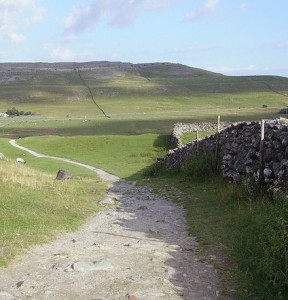Found– Walking by G.M. (George Macaulay) Trevelyan* (Mitchell, Hartford,  Connecticut 1928) – a special American edition. The great historian ‘s paean to the joys of walking (” I have two doctors, my left leg and my right..’) was published first as an essay in 1913 in Clio, a muse, and other essays literary and pedestrian and the American introduction by J. Brooks Atkinson notes that the walking world has changed much since then: “..the motor car has completely separated the walkers from the riders. It lays a new responsibility upon the walkers to conduct themselves nobly in God’s light.. they cannot be road walkers now, like Stevenson, since roads have become arteries -hardened arteries- of traffic. They are pushed willy-nilly into the hills, meadows and woods beyond the clatter and the evil fumes of the highway..” (he then launches an attack on the new walking clubs- ‘their walking is a bastard form of motoring.’) Trevelyan’s essay recalls a world now largely lost, although our great modern walkers (Iain Sinclair, Robert Macfarlane, Will Self) still find great places to ramble. GMT writes:
Connecticut 1928) – a special American edition. The great historian ‘s paean to the joys of walking (” I have two doctors, my left leg and my right..’) was published first as an essay in 1913 in Clio, a muse, and other essays literary and pedestrian and the American introduction by J. Brooks Atkinson notes that the walking world has changed much since then: “..the motor car has completely separated the walkers from the riders. It lays a new responsibility upon the walkers to conduct themselves nobly in God’s light.. they cannot be road walkers now, like Stevenson, since roads have become arteries -hardened arteries- of traffic. They are pushed willy-nilly into the hills, meadows and woods beyond the clatter and the evil fumes of the highway..” (he then launches an attack on the new walking clubs- ‘their walking is a bastard form of motoring.’) Trevelyan’s essay recalls a world now largely lost, although our great modern walkers (Iain Sinclair, Robert Macfarlane, Will Self) still find great places to ramble. GMT writes:
The secret beauties of Nature are un-veiled only to the cross-country walker. Pan would not have appeared to Pheidippides on a road. On the road we never meet the “moving accidents by flood and field ” : the sudden glory of a woodland glade ; the open back-door of the old farmhouse sequestered deep in rural solitude ; the cow routed up from meditation behind the stone wall as we scale it suddenly ; the deep, slow, south-country stream that we must jump, or wander along to find the bridge ; the northern torrent of molten peat-hag that we must ford up to the waist, to scramble, glowing warm-cold, up the farther foxglove bank ; the autumnal dew on the bracken and the blue straight smoke of the cottage in the still glen at dawn ; the rush down the mountain side, hair flying, stones and grouse rising at our feet ; and at the bottom the plunge in the pool below the waterfall, in a place so fair that kings should come from far to bathe therein yet is it left, year in year out, unvisited save by us and “troops of stars.”
These, and a thousand other blessed chances of the day, are the heart of Walking, and these are not of the road. Yet the hard road plays a part in every good walk, generally at the beginning and at the end. Nor must we forget the “soft” road, mediating as it were between his hard artificial brother and wild surrounding nature. The broad grass lanes of the low country, relics of mediaeval wayfaring; the green, unfenced moorland road; the derelict road already half gone back to pasture ; the common farm track these and all their kind are a blessing to the walker,to be diligently sought out by help of map** and used as long as may be. For they unite the speed and smooth surface of the harder road with much at least of the softness to the foot, the romance and the beauty of cross-country routes.
It is well to seek as much variety as is possible in 12 hours. Road and track, field and wood, mountain, hill, and plain should follow each other
in shifting vision.
…Places where the fairies might still dwell lie for the most part west of Avon. Except the industrial plain of Lancashire the whole West from Cornwall to Carlisle is, when compared to the East of our island, more hilly, more variegated, and more thickly strewn with old houses and scenes unchanged since Tudor times. The Welsh border, on both sides of it, is good ground. If you would walk away for a while out of modern England, back and away for twice two hundred years, arrange so that a long day’s tramp may drop you at nightfall off the Black Mountain onto the inn that nestles in the ruined tower of old Llanthony…
* Robert Tombs (2015) in The English and Their History notes that GMT was once called “probably the most widely read historian in the world; perhaps in the history of the world.”
**Compass and coloured half-inch Bartholomew is the walkers vade mecum in the North; the one-inch ordnance is more desirable for the more enclosed and less hilly south of England.

Thanks. I wonder if ‘the inn that nestles in the ruined tower of old Llanthony’ is still there?